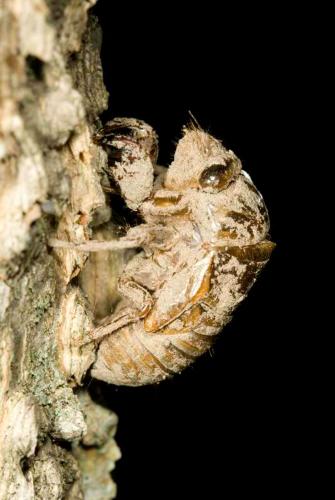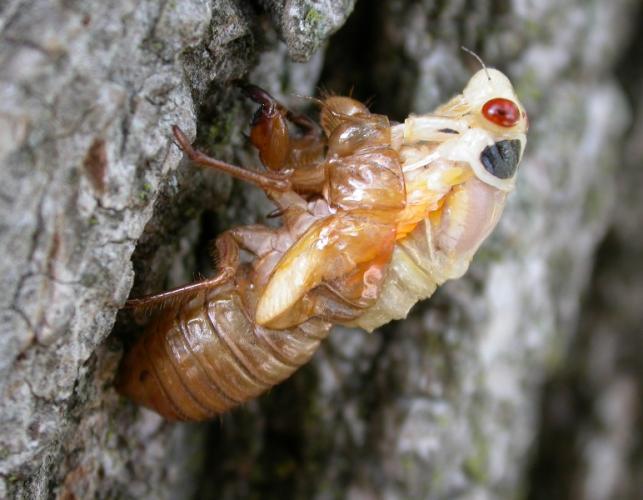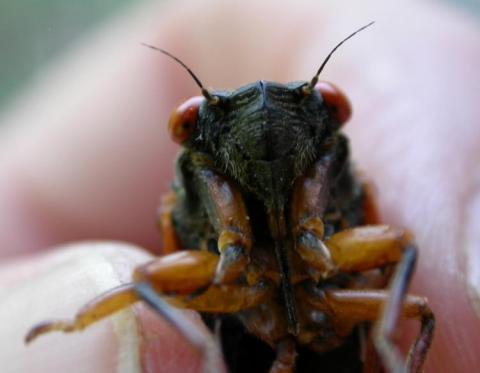Periodical cicadas are insects that emerge as broods every 13 or 17 years, depending on the brood. Mass emergences can range over several states. They generally start emerging in May and remain above ground through most of June. The enormous number of cicadas emerging at one time swamps birds and other cicada predators with more juicy insect food than they can consume. This allows most of the cicadas in the brood to survive and produce another generation that will live in the ground for the next 13 or 17 years.
Periodical cicadas are different from the familiar annual cicadas, also called “dog-day cicadas,” which emerge from the ground every year and make their droning noise during the heat of late summer.
Brood History and Outlook
There are three broods of 13-year cicadas and 12 broods of 17-year cicadas in existence, and they occur only in the eastern half of the United States. Broods differ in their locations and emergence timing. Only four broods of periodical cicadas extend into parts of Missouri: two of the 13-year type and two of the 17-year type.
1998. This emergence consisted of the brood of 17-year cicadas (known as Brood 4) in western Missouri and a brood of 13-year cicadas (known as Brood 19) over much of the rest of the state. It was the two broods’ first convergence (some overlapping territories) since 1777.
2002. Brood 23 (a 13-year cicada) emerged in southeastern Missouri.
2011. Brood 19, the largest periodical cicada brood in Missouri, emerged again in huge numbers.
2014. Brood 3 (a 17-year cicada) occurred at the northern edge of the state, but because so little of it occurred within our borders, most Missourians didn't notice it.
2015. Brood 4 emerged again in western Missouri, as did Brood 23 in southeastern Missouri. Unlike the two converging broods of 1998, the two 2015 broods were widely separated, with no overlap in territory. This is the only time during the 21st century when two Missouri broods emerge in the same year.
2024. Brood 19, the largest Missouri brood, returns to put on its impressive display once again across most of the state.
2028. Brood 23 emerges in southeastern Missouri.
2031. Brood 3 emerges along Missouri’s northern border.
2032. Brood 4 emerges in western Missouri.
Just a few weeks above ground every 13 or 17 years
As temperatures warm in late April, immature cicadas (nymphs) open up 1/2-inch-wide holes in the soil surface.
- They may build 3- to 5-inch-tall mud chimneys or towers above their holes.
- In early May, the cicada nymphs, brown and wingless, emerge from the soil, climb up on tree trunks or other objects, and shed their exoskeletons, leaving the shell-like “skins” behind.
- Adult males will begin their noisy “singing” a few days after shedding their exoskeleton and expanding their new wings.
- Males congregate in “choruses” and sing to attract females.
- After mating, females cut slits in pencil-sized tree twigs and deposit their eggs there.
- Eggs hatch in six to 10 weeks, and the tiny cicada offspring return to the safety of underground burrows, where they feed on roots until they mature and stage the next mass emergence.
They can affect young trees, but typically don't damage mature ones
Female cicadas use a saw-like appendage on the abdomen to slice into 1/4- to 1/2-inch diameter tree twigs and deposit their eggs. Leaves on damaged twigs turn brown, and some twigs may die. This “flagging” can be quite visible in areas with large numbers of cicadas.
They can do serious damage to fruit orchards and nursery stock, as well as to young trees growing in the landscape.
What You Can Do To Control Possible Damage
- The effect on mature trees is minor, so pesticide use is not recommended.
- If placed over branches and tied closed on the trunk, cheesecloth, mosquito netting or netting with mesh smaller than 1/4 inch is effective for protecting small trees.
Other Cool Things To Know
They "sing" with drumlike structures on their abdomens
Although periodical cicadas are about half the size of an adult pinkie finger, these musical insects can drown out a chainsaw. Male cicadas are the singers. They use a pair of drum-like structures called tymbals to produce their song. The tymbals are located on their abdomens, just behind the last pair of legs. They make sound in a similar way to a plastic soft drink bottle popping back into shape after being compressed. Cicadas flex the tymbals rapidly making a loud click each time, which creates a high-pitched droning sound.
You can use them for bait
A periodical cicada emergence creates a brief food bonanza for birds and fish. It also creates opportunities for anglers. As fish go on feeding binges, anything resembling a cicada can prompt a bite.
| Periodical Cicadas | Annual Cicadas | |
|---|---|---|
| Body colors | Black body with orange markings and red eyes | Brown, green and white body with dark-colored eyes |
| Time of emergence | Adults present in May and June | Adults present from late June to August |




























